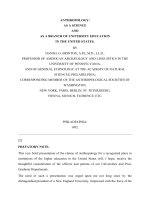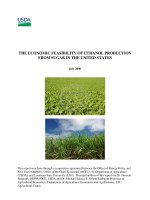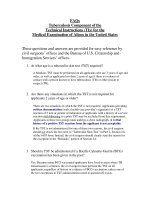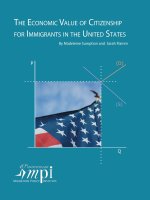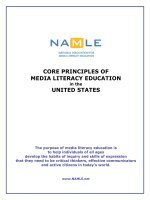Metaphor in the Declaration of Independence of the United States
Bạn đang xem bản rút gọn của tài liệu. Xem và tải ngay bản đầy đủ của tài liệu tại đây (143.1 KB, 3 trang )
Metaphor in the Declaration of Independence of
the United States
Nguyễn Thị Thanh Bình
Trường Đại học Ngoại ngữ
Luận văn Thạc sĩ ngành: English Linguistics; Mã số: 60 22 15
Người hướng dẫn: M.A. Nguyễn Hương Giang
Năm bảo vệ: 2012
Abstract. This paper investigates typical conceptual metaphors used in the Declaration
of Independence of USA by Thomas Jefferson, the USA president. Metaphor is
traditionally treated as rhetoric device in poetics. However, according to cognitivists,
metaphor is not merely a matter of language but a matter of thought. Metaphor plays a
very important role in expressing emotion and influencing to audiences effectively. The
author tries to present classical cognitive theory of metaphor proposed by George
Lakoff and Mark Johnson. This study consists of three main parts. The first part,
INTRODUCTION, gives general information about the rationale, the aim, the scope,
the methods and the design of the study. The second part, DEVELOPMENT, involves
two chapters. Chapter 1, AN OVERVIEW OF METAPHOR, provides the theoretical
background on conceptual metaphor, the classification and functions of conceptual
metaphor. Chapter 2, THE STUDY, figure out the conceptual metaphor in the
Declaration and how they affect the audience. The last part, CONCLUSION, reveals all
types of conceptual metaphor including ontological metaphor, structural metaphor and
orientational metaphor used in the Declaration. These conceptual metaphors have
definite emotional effect on the audience to fulfill the purpose of delivering this
Declaration. Also, some suggestions for further study are presented in this part.
Keywords. Ngôn ngữ; Tiếng Anh; Ngữ pháp; Phương pháp ẩn dụ
Content
1. Rationale
Metaphor is one of the most complex and powerful tools of language and hence gets a
section all to itself. It is widely used in different types of text like literature, science, journals,
advertisement, religion, politics or everyday language. The use of metaphor as a part of
figurative language aims to help the listeners to visualize what is meant by a phrase or
expression. It is seen everyday and every time by almost everybody. In fact, politicians use
language to persuade people that their thoughts, aims and ideas are equitable and to make their
point clear and vivid to the people. It is proved that the use of metaphor is one of the most
prominent tools for persuasion and an effective instrument for propaganda in political language.
Commenting on the important role of metaphor, George Lakoff and Mark Johnson (1980:3) state
that “metaphor is pervasive in everyday life, not just in language but in thought and action”
The Declaration of Independence is delivered to announce independence and sovereignty
of any countries to not only their citizens but also other countries in all over the world.
Therefore, its author has to use rhetorical strategies to convince people and metaphor is one of
the rhetorical strategies which are found to be commonly used. Thus, I would like to conduct a
study on the use of metaphor in the Declaration of Independence of the United States to find out
what types of metaphor are commonly used and how effective they are.
2. Aims of the study
This study was conducted to fulfil the following aims:
To provide knowledge about conceptual metaphor from Lakoff and Johnson’s
perspective
To investigate the use of conceptual metaphor in the Declaration of Independence of the
United States
To give suggestion on some teaching and learning activities to gain more understanding
about metaphor.
These aims of the study were achieved via the following research questions:
What is conceptual metaphor?
How many types of conceptual metaphor are there?
What types of conceptual metaphor are used in The Declaration of
Independence of the United States?
3. Scope of the study
This study attempts to look at theories of metaphor. Cognitive theory about metaphor
developed by Lakoff and Johnson will be presented in details in terms of definition, components,
classification and functions. Then, the Declaration of Independence of the USA is analysed using
Lakoff and Johnson’s theory to figure out typical conceptual metaphors in this writing.
4. Methods of the study
The study is carried out mainly based on the combination of both descriptive and
explanatory methods. These two methods were used to collect data different books and other
sources available, describe the collected information and analyze the Declaration of
Independence of the USA. The study was conducted as follows:
Firstly, data was collected from different books, websites about metaphor in English.
Secondly, the collected information was synthesized and categorized
Finally, the Declaration of Independence was analyzed in terms of metaphor.
5. Design of the study
The study consists of 3 main parts: Introduction, Development and Conclusion.
The Introduction presents the rationale, aims, scope, methods and design of the study.
The Development is divided into 2 chapters. Chapter 1 deals with theoretical background
of the study including different theories of metaphor. Chapter 2 accounts for the study of
conceptual metaphors used in Declaration of Independence of America.
The Conclusion focuses on major findings, implications and suggestions for further
studies.
References
1. Dirver R. & Roings R. (2003), Metaphore and Metonymy in Comparison and Contrast,
Mouton de Gruyter. Berlin, New York.
2. Pound, Ezra. (1913), "A Retrospect" Literary Essays of Ezra Pound. Ed. T. S. Eliot. New
York.
3. Higara M.K. (2005), Metaphor and Iconicity. A cognitive approach to Analyzing texts,
Printed and bound in Great Britain by Antony Rowe Ltd, Chppenham & Eastbourne.
4. Lakoff G. & Johnson M. (1980), Metaphors We live by, Chicago University Press,
Chicago and London.
5. Lakoff G. & Turner M. (1989) More than cool Reason, Chicago University Press.
6. Lakoff G. (1993), The Comterporary theory of Metaphor, Cambridge Universit Press,
Cambridge.
7. Leezengberh M. (2001), Contexts of Metaphor, Univeristy Of Amsterdam, Elsevier
Science Ltd, the Netherlands.
8. Richards I.A (1936) The philosophy of rhetoric, Oxford Univeristy Press, London.
9. William Harmon .& C.Hugh Homan (1999), A handbook to Literature, The Odyssey
Press, New York
10. Zoltan Koveceses. (2010), Metaphor: A pratical introduction, Oxford University Press,
London.
11. The Oxford Advanced Leaner’s 7
th
Edition, 2007. Oxford University Press, London
12. The Cambridge Advanced Learner’s Dictionary 3
rd
Edition, 2008. Cambridge University
Press, Cambride.
WEBS
retrieved 15/9/2012
retrieved 15/9/2012
ipedia, retrieved 20/08/2012
dickinson/ the complete poems 1924, retrieved 15/9/2012
John Ciardi, World Book Dictionary
retrieved 20/8/2012

